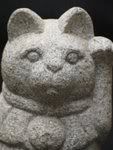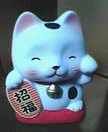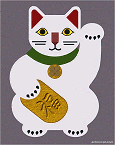Do you have a Maneki Neko?
I' v always wondered what that all abt. I know that it is not a chinese thing. I can see it in store fronts, I know that it is for good luck but what are the origins?
The Legend
This was so startling that he left the shelter of the tree to have a closer look at this unusual cat. At that moment, the tree was struck by lighting. As a result, the wealthy man became friends with the poor priest, and the temple became prosperous. The priest and his cat never went hungry again. When Tama died he was buried in the Goutokuji Temple's cat cemetery with respect and love, and the Maneki Neko was made in honor of him.
A Maneki Neko in your place of business, your home or on your website is said to bring in good luck and visitors. Maneki Neko is Japanese for "beckoning cat." The message he's holding says "Please come in. You are welcome!" and he is beckoning you with his paw . In Japan, the gesture of beckoning is pretty much the reverse of the gesture used in the West.
The Culture
 Japanese merchants are very superstitious. They always keep some kind of lucky charm at the front or back of their stores hoping for lots of customers and thriving business. There are lots of lucky charms in Japan. For example, the Seven Deities of Good Fortune which include Ebisu and Daikoku. Fuku Suke, Dharma, Otafuku, Tanuki are very popular, also. Even a snake can be considered a lucky charm in Japan.
Japanese merchants are very superstitious. They always keep some kind of lucky charm at the front or back of their stores hoping for lots of customers and thriving business. There are lots of lucky charms in Japan. For example, the Seven Deities of Good Fortune which include Ebisu and Daikoku. Fuku Suke, Dharma, Otafuku, Tanuki are very popular, also. Even a snake can be considered a lucky charm in Japan. Among so many lucky charms, Maneki Neko is the most popular. Every Japanese knows its existence. Why is it so popular? The reason may lie in its lovely character. Men and women, young and old, everyone falls in love with its round face and big eyes;at first sight. This is the reason Maneki Neko appears in lots of corporate advertisements. Many different small products borrow the design of Maneki Neko.
There are two different kinds of Maneki Neko. One raises its left paw. The other raises its right paw. The legend specified that the one with its left paw up invited customers or people, and the one with its right paw up invited money or good fortune. The origin of this legend was not clear.
The Cat

The gesture of Maneki Neko looks like it is inviting someone. It is actually representing a gesture of a cat washing its face. Before it starts to rain, many cats wash their faces because they can feel the changing weather pattern. The keen sensory of a cat can detect the minute environmental changes, which make a cat uneasy. This is why a cat washes its face. It is trying to ease its anxiety. Lots of places around the world have the proverb, "If a cat washes its face, it will rain."
Some people think an old saying from 9th Century China, "If a cat washes its face and ears, it will rain." might have been the origin of Maneki Neko folklore. Do you think a person will really visit you when a cat washes its face ? Since a cat is a sensitive animal, it becomes nervous when it notices a person approaching. When it becomes nervous, a cat sometimes starts wandering around or washing its face.
These behaviors comfort the cat. A cat washes its face to relieve the anxiety toward the approaching visitor. But for a human being, it looks like " If a cat washes its face, a visitor will come." This concept was combined with the fact that the gesture of a cat washing its face looked like a beckoning gesture. So, the people started a simple belief that if a person placed a figurine of a cat raising its front paw, which represents a beckoning gesture, the customers would come in.


|